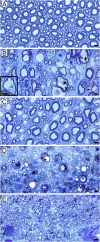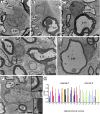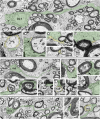The adult oligodendrocyte can participate in remyelination
- PMID: 30487224
- PMCID: PMC6294923
- DOI: 10.1073/pnas.1808064115
The adult oligodendrocyte can participate in remyelination
Abstract
Endogenous remyelination of the CNS can be robust and restore function, yet in multiple sclerosis it becomes less complete with time. Promoting remyelination is a major therapeutic goal, both to restore function and to protect axons from degeneration. Remyelination is thought to depend on oligodendrocyte progenitor cells, giving rise to nascent remyelinating oligodendrocytes. Surviving, mature oligodendrocytes are largely regarded as being uninvolved. We have examined this question using two large animal models. In the first model, there is extensive demyelination and remyelination of the CNS, yet oligodendrocytes survive, and in recovered animals there is a mix of remyelinated axons interspersed between mature, thick myelin sheaths. Using 2D and 3D light and electron microscopy, we show that many oligodendrocytes are connected to mature and remyelinated myelin sheaths, which we conclude are cells that have reextended processes to contact demyelinated axons while maintaining mature myelin internodes. In the second model in vitamin B12-deficient nonhuman primates, we demonstrate that surviving mature oligodendrocytes extend processes and ensheath demyelinated axons. These data indicate that mature oligodendrocytes can participate in remyelination.
Keywords: adult oligodendrocyte; large animal models; remyelination.
Conflict of interest statement
The authors declare no conflict of interest.
Figures







References
-
- Franklin RJM, Ffrench-Constant C. Regenerating CNS myelin—From mechanisms to experimental medicines. Nat Rev Neurosci. 2017;18:753–769. - PubMed
-
- Prineas JW, Connell F. Remyelination in multiple sclerosis. Ann Neurol. 1979;5:22–31. - PubMed
-
- Raine CS, Wu E. Multiple sclerosis: Remyelination in acute lesions. J Neuropathol Exp Neurol. 1993;52:199–204. - PubMed
-
- Lassmann H, Brück W, Lucchinetti C, Rodriguez M. Remyelination in multiple sclerosis. Mult Scler. 1997;3:133–136. - PubMed
Publication types
MeSH terms
LinkOut - more resources
Full Text Sources
Other Literature Sources

